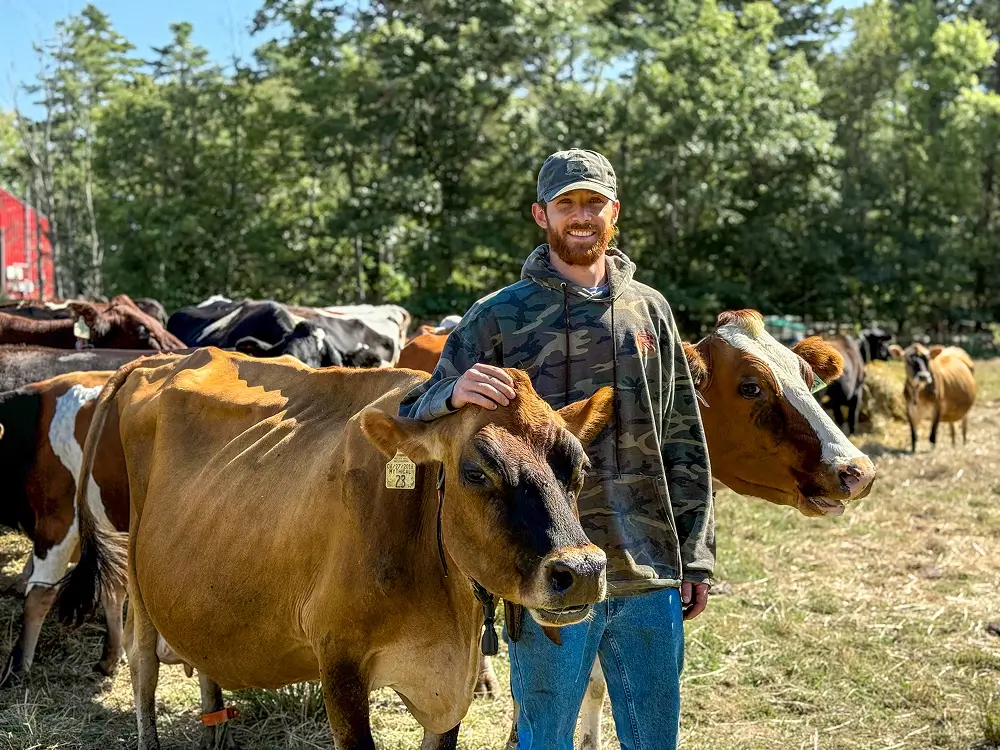This blog is part of our series of Wolfe’s Neck Center Stories, focusing on the people and the programs that drive our work for farmer viability, thriving ecosystems, and vibrant communities.
Advancing the science of regenerative agriculture requires time, acreage, and risk that production farms often can’t spare. At Wolfe’s Neck Center for Agriculture & the Environment, we put our landscape, nonprofit status, and deep regional partnerships to use building this knowledge and passing it along to farmers in Maine and across the Northeast.
What does that look like? On the one hand, as part of our Research and Demonstration program area, we have a diverse and growing portfolio of research projects and partners. Our organic dairy herd is involved in a trial to test if seaweed additives are safe and practical replacements for mineral supplements. This research, funded by the USDA and led by collaborators from the University of Vermont, the University of New Hampshire, Hudson Carbon, and the Bigelow Laboratory for Ocean Sciences, explores synergies between on-land and coastal agriculture that could improve profitability and reduce environmental impact in important Maine industries.
Much of our other research is focused on soil health, including another USDA-funded experiment run by our partners at American Farmland Trust (AFT). This study is looking at whether amending the soil with biochar – a charcoal-like substance that can improve soils while reducing greenhouse gases by putting carbon in the ground – will affect vegetable yields. We also work in partnership with The Soil Inventory Project (TSIP) to provide soil analysis to help farmers make individual land management decisions. TSIP then pools that data to demonstrate the positive impact of regenerative agriculture practices at scale.

This growing focus on research and scientific measurement is rooted in the rich history of demonstration at Wolfe’s Neck Center. “If you visit the farm, you can see different regenerative agriculture demonstrations,” says Wolfe’s Neck Center / UMaine Extension Research Scientist Laura Sofen, including applications of agroforestry like the beachplum windbreaks in our West Bay pasture that provide shelter to vegetable crops. “We aim to analyze soil health indicators and other measurements to quantify the impact of these practices and help farmers make informed choices.”
Laura’s role here is new, as is our exciting collaboration with the University of Maine Cooperative Extension. UMaine Extension puts university research to work in homes, businesses, farms, and communities in every corner of the state. Wolfe’s Neck Center has a lot to provide to that mission. “By establishing this location as a research and demonstration site in collaboration with Extension,” Laura says, “we offer a place to experiment with marine clay soil that is common in coastal Maine farms, so that results and recommendations are applicable to a whole new group of farmers.”
Laura has a PhD in chemistry and comes to Wolfe’s Neck Center from Bigelow Laboratory for Ocean Sciences. She spent 3 years in Panama as an agricultural extension agent with the Peace Corps. At Wolfe’s Neck Center, Laura will develop a forward-looking research agenda that addresses critical agricultural challenges facing the Northeast farming community, while building educational and outreach programming that shares research findings with farmers and the public.
Our soils are not the only thing unique about Wolfe’s Neck Center; our combination of active farming operations with a community-supported nonprofit structure allows us to step up for the agricultural community. “If a crop fails because we were trying something new, we’re not going out of business,” Laura says. But we might have learned something that can help a commercial farm make decisions that are better for their bottom line, or a neighboring ecosystem – or both.
Visit our website to learn more about our on-campus research activities – and keep checking back for updates as our research efforts continue to grow!
